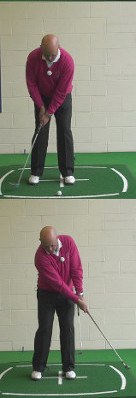Keeping Your Head Down Techniques in the Short Game

From a physical perspective, this is a very simple topic to cover in our last section. You are going to set up over the ball in a comfortable position, and you are going to leave your head as still as possible while you hit the shot. That’s it. There is no big, dynamic swing to make in the short game, which means you don’t have to worry about coordinating moving parts and keeping your head still in the middle of it all. Your body is going to move very little while hitting a putt or a chip shot, and your head should not move at all.
So, if this is such a simple topic, why do we need to address it at all? Simple – the mental side of this issue is a major hurdle for countless golfers. When playing a short game shot, you are – by definition – rather close to the hole. That means it is not hard to see the hole, if you just take a little look up from the ball and peer to your left. This temptation is awfully strong, especially when hitting short putts. Instead of keeping your head down and stable as you should do until your stroke is complete, you might feel like looking up early to see if the ball is going to go in. This is a classic golf mistake, and one which has been made by every player in the game at least once or twice.
The solution to this problem is the same as it is in the long game – discipline. You have to teach yourself that nothing is going to be gained by looking up early. If you look up from the ball prematurely, you are only going to make it less likely that your shot will be a success in the end. Pick out a spot on the ball, just as you did before, and train your eyes on that spot until the ball is gone. Only then are you free to look up and see how you’ve done. Happily, by keeping your head down all the way through the shot, you will be able to look up and see successful outcomes far more frequently.
We hope this discussion on an important golf fundamental will help point you in the right direction. Keeping your head down can go a long way toward improving your play on the course, but only if you do it properly. The information we have provided should allow you to make progress as soon as your next practice session – good luck!






